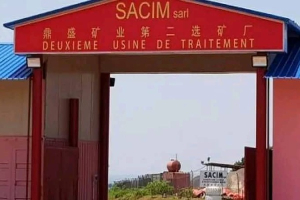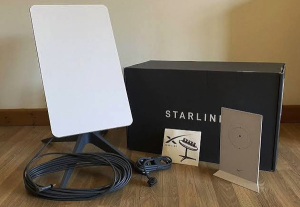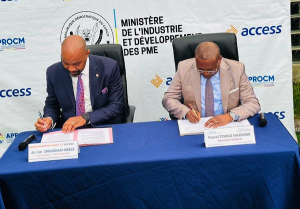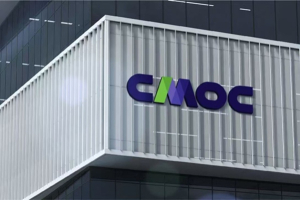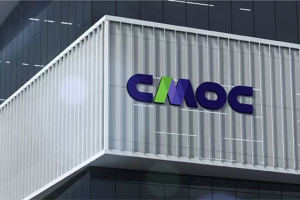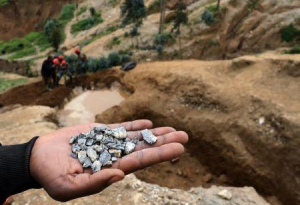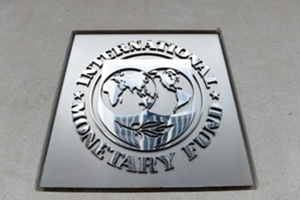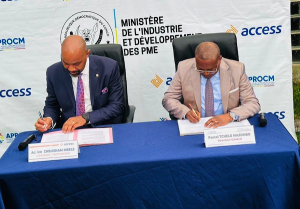Equipe Publication
Dotation communautaire : la SACIM menacée de suspension pour 700 000 $ d’impayés
La Société Anhui-Congo d’investissement minier (SACIM) fait partie des trois entreprises minières visées par une recommandation de suspension des activités, émise par la Cour des comptes. Dans son rapport d’audit publié en juin, l’institution reproche à ces sociétés de ne pas avoir versé la dotation légale de 0,3 % de leur chiffre d’affaires, destinée au financement de projets communautaires dans les zones d’exploitation.
Cette recommandation survient dans un contexte déjà difficile pour SACIM. Récemment, l’entreprise a subi des restrictions sur la vente de ses diamants, ne pouvant les écouler qu’auprès d’un nombre restreint d’acheteurs. Bien que cette mesure ait été levée, elle a eu un impact négatif sur la santé financière de la société, entraînant la paralysie de ses activités. Privés de treize mois de salaires, les ouvriers ont organisé plusieurs mouvements de grève pour dénoncer la situation.
À Miabi (Kasaï Oriental), principal site d’exploitation de SACIM, la société civile locale déplore que les communautés n’aient jamais bénéficié de cette dotation depuis l’installation de l’organisme spécialisé en 2022. Selon la Cour des comptes, l’entreprise doit près de 700 000 dollars au titre de cette contribution, censée soutenir le développement local.
La Cour cite également OM Metal Resources et la Société de traitement du terril de Lubumbashi comme autres contrevenants. Ensemble, les trois entreprises auraient accumulé une dette de 2,77 millions de dollars entre 2018 et 2023, malgré des chiffres d’affaires significatifs.
L’institution déplore l’inaction du Comité de supervision, qui n’a pas apporté la preuve de sanctions à l’encontre des entreprises défaillantes, malgré plusieurs mises en demeure. Elle rejette l’argument selon lequel la préservation du climat des affaires justifierait une telle souplesse. Pour la Cour, le respect des obligations légales ne saurait constituer un frein à l’investissement, d’autant que ces entreprises s’acquittent par ailleurs d’autres formes de fiscalité.
Dans sa recommandation, elle enjoint le Comité de supervision, par l’entremise du ministre des Mines, de procéder à la suspension des activités des entreprises concernées, conformément à l’article 292 du Code minier, jusqu’au règlement intégral des sommes dues.
Ronsard Luabeya, stagiaire
Développement local : 198 millions $ non versés par les sociétés minières en RDC
SACIM : le coup de pression de Ngoyi Kasanji pour plus de résultats
Diamant : la RDC dans la coalition africaine contre la montée du synthétique
Diamant : la production de la RDC chute de 26 % au premier trimestre 2025
DRC Considers Tax Cuts to Boost Starlink Satellite Internet Access
The Democratic Republic of Congo (DRC) is preparing to swiftly adopt "appropriate" tax and parafiscal incentives to facilitate equipment importation and reduce the cost of satellite internet access. During the Council of Ministers meeting on June 20, 2025, President Félix Antoine Tshisekedi instructed the government to propose fiscal relief to accelerate the rollout.
On May 2, 2025, a license was granted to Starlink RDC S.A., the local subsidiary of SpaceX’s satellite internet provider. The company has since begun offering services in the country. For its residential service, the most affordable installation kit is currently priced at 575,000 Congolese francs, which is a little over $205 at the current exchange rate. The unlimited monthly subscription costs 144,000 FC, or more than $51. A more limited plan, offering up to 250 GB of data, is also available at 87,000 FC, or $31, per month.
According to Starlink, speeds can reach 270 Mbps. For comparison, achieving similar unlimited speeds with Orange or CanalBox in a residential package costs $99 and $89 per month, respectively. Excluding hardware, Starlink is already more competitively priced than its rivals. Furthermore, while competitors limit coverage to certain neighborhoods in Kinshasa, Starlink offers citywide access. The primary drawback remains the equipment cost. With the tax exemptions directed by the president, Elon Musk’s venture could widen its lead over the competition.
In 2023, only 30.79% of Congolese had access to mobile internet, and less than 0.02% to fixed broadband, according to the Congolese Post and Telecommunications Regulatory Authority (ARPTC). To expand connectivity, President Tshisekedi is banking on the deployment of Starlink and other satellite internet providers, such as Monacosat, with whom the DRC signed a memorandum of understanding on November 12.
He emphasized that satellite internet projects "must not be slowed down" by "legal and regulatory barriers" or by "weak investment in the sector." The technology, he argues, should help "bypass the constraints of physical infrastructure and more quickly bridge the country’s digital divide."
Written in French by Boaz Kabeya (intern),
Translated and adapted into English by Mouka Mezonlin
Access Bank Launches $25mln SME Financing Plan in DR Congo
Access Bank RDC, the Congolese subsidiary of Nigeria’s Access Bank Group, is stepping up its support for small and medium-sized businesses (SMEs) with a new financing program. The bank plans to inject $25 million into SME lending in the Democratic Republic of Congo during the second half of 2025.
The plan, outlined in the bank’s Pillar 3 report published on May 5, 2025, took a key step forward on June 28, when Access Bank signed a memorandum of understanding with the Agency for the Promotion of the Congolese Middle Class (Aprocm).
To limit risk, Access Bank will rely on Aprocm’s database, which contains detailed information on registered SMEs. The goal is to identify the most reliable businesses and tailor offers ranging from loans to cash management and training programs. Aprocm will support SMEs with technical assistance and help raise awareness about the financing opportunities available.
Aprocm, established in 2021, works to develop an entrepreneurial middle class in the DRC. It manages the platform created under the Support Project for the Development of Micro, Small, and Medium Enterprises (PADMPME), which connects entrepreneurs with specialized service providers.
Access Bank aims to expand its footprint in the Congolese banking sector. In 2024, its total assets stood at $409.8 million, falling short of its initial target of $524 million. The bank now targets $750 million in assets by 2025, representing a 7.6% increase over its 2024 projections.
The Pillar 3 report did not specify how much the SME segment is expected to contribute to this growth. However, it shows that outstanding SME loans stood at 43.4 billion Congolese francs in 2024, equivalent to $15.4 million based on the average annual exchange rate.
Bread Shortages Grip Inongo as Wheat Flour Prices Soar 50%
• Wheat flour cost jumps from 120,000 to 180,000 Congolese francs since late June.
• Kinshasa supply disruptions trigger cascading shortages in Maï-Ndombe province.
• Bakeries scale back or shut down, deepening food insecurity.
Bread has become increasingly scarce in Inongo, the capital of Maï-Ndombe province, as wheat flour prices have surged 50% since late June, local traders said on Tuesday.
A 50kg sack of flour now costs 180,000 Congolese francs ($63), up from 120,000 francs, due to supply shortages in Kinshasa, the region’s main distribution hub. “We are experiencing the domino effect of the scarcity in Kinshasa. Our warehouses have been empty for days,” said Rodrigues Mbolia, manager of Super Mima depot, according to the Congolese Press Agency.
Even before the latest spike, Inongo’s markets were under strain. Since April, staples such as cassava and fish have been in short supply amid disputes between city hall and vendors accused of speculative pricing. Authorities imposed price caps that were later relaxed—up to 50% margins to account for logistics—but the measures disrupted distribution networks.
Some producers were instructed to sell directly at markets, bypassing intermediaries and fueling tensions along the supply chain.
Bread, a staple food, has now become hard to find. Many bakeries have cut production or closed temporarily, citing lack of flour and poor profitability. The situation has worsened food insecurity in a city already grappling with inflation and falling purchasing power.
Local authorities have urged residents to remain patient while awaiting new deliveries, but no timeline or logistics plan has been announced, leaving uncertainty over when supplies will stabilise.
This article was initially published in French by Boaz Kabeya (intern)
Edited in English by Ola Schad Akinocho
Cobalt: CMOC Halts Deliveries Amid DRC Export Ban Extension
IXM, the metals trading unit of China Molybdenum (CMOC), declared force majeure on its cobalt supply contracts on June 30. This decision followed the Democratic Republic of Congo’s (DRC) extension by three months of the cobalt export ban, which was initially imposed on February 22, 2025.
IXM explained that the extended export ban makes it both legally and practically impossible for its suppliers—including Tenke Fungurume Mining and CMOC Kisanfu Mining—to export cobalt-based products from the DRC. This situation directly affects IXM’s ability to fulfill its contractual obligations. The company emphasized that despite the increased volatility in the global cobalt supply chain, it remains committed to managing this disruption responsibly while respecting all contractual and regulatory frameworks.
According to S&P Global Ratings, a European market participant noted that the suspension was inevitable and expressed surprise that it had taken this long to occur. Earlier in March, Telf AG, which markets cobalt for Eurasian Resources Group (ERG), had already declared force majeure to its clients. Glencore, another major player active in the DRC, publicly supported the extension of the export embargo.
IXM’s announcement is likely to unsettle markets amid growing uncertainty about global cobalt supplies. The suspension of exports particularly impacts Chinese refiners, who depend heavily on cobalt hydroxide imports from the DRC.
Behind this export ban, the Congolese government seeks to capture more value from cobalt, a strategic mineral currently sold in raw form on global markets. The country’s mining code imposes a special 15% royalty on cobalt due to its strategic importance. Moreover, the government may impose a superprofit tax if the selling price exceeds the projections made in companies’ feasibility studies.
A Risky Strategy
The public Enterprise Générale du Cobalt (EGC) now manages a significant portion of artisanal cobalt mining. This state entity aims to improve revenue collection from a sub-sector that has long operated informally.
Cobalt prices stood at $33,335 per ton on June 30, 2025, according to Trading Economics. This price represents a 61.7% increase since the initial export suspension was announced. However, it remains well below previous peaks of $79,191 in April 2022 and $95,856 in March 2018.
Market observers warn that the DRC’s hardline approach could discourage mining companies from investing or continuing operations in the country. On a global scale, the export ban could accelerate the development of alternative cobalt projects in countries such as Indonesia, Australia, and Canada.
In 2024, the DRC accounted for 73.6% of the world’s cobalt supply. However, S&P Global Market Intelligence projects that this share could decline to 57% by 2035 due to the gradual depletion of ore reserves and Indonesia’s expanding refining capacity using high-pressure acid leaching (HPAL) technology.
Facing these uncertainties, manufacturers of batteries and electric vehicles—who rely heavily on Congolese cobalt—are accelerating their diversification efforts. These efforts include securing long-term supply contracts with other countries, investing in battery recycling technologies, and developing cobalt-free energy storage solutions. Producers of consumer electronics are pursuing similar strategies.
Georges Auréole Bamba
Cobalt : CMOC suspend ses livraisons à cause du gel des exportations en RDC
Le négociant en métaux IXM, filiale du groupe chinois China Molybdenum (CMOC), a annoncé le 30 juin avoir déclaré un cas de force majeure sur ses contrats de fourniture de cobalt. Cette décision intervient quelques jours après que la République démocratique du Congo (RDC) a prolongé de trois mois l’interdiction d’exporter le cobalt, initialement imposée le 22 février 2025.
Dans un communiqué, IXM précise que cette interdiction prolongée « rend légalement et pratiquement impossible à ses fournisseurs, dont Tenke Fungurume Mining et CMOC Kisanfu Mining, d’exporter des produits à base de cobalt depuis la RDC », affectant directement sa capacité à honorer ses engagements contractuels. « Alors que la chaîne d’approvisionnement mondiale en cobalt connaît une volatilité accrue, IXM reste engagé à gérer cette perturbation de manière responsable, dans le respect des cadres contractuels et réglementaires », ajoute l’entreprise.
Selon des propos rapportés par S&P Global Ratings, un acteur européen du marché a réagi : « C’était une question de temps — on pourrait même être surpris que cela ait pris autant de jours ». En mars dernier, Telf AG, responsable de la commercialisation du cobalt d’Eurasian Resources Group (ERG), avait déjà invoqué la force majeure auprès de ses clients. Glencore, autre géant du secteur actif en RDC, s’est pour sa part montré favorable à la prolongation de l’embargo.
Pour ce même opérateur européen, l’annonce d’IXM pourrait provoquer un effet psychologique sur les marchés, en raison de l’incertitude grandissante sur l’approvisionnement mondial. À ce stade, la suspension des exportations congolaises de cobalt affecte particulièrement les raffineurs chinois, très dépendants des importations d’hydroxyde de cobalt en provenance de la RDC.
En toile de fond, Kinshasa affiche sa volonté de mieux capter la valeur ajoutée de ce minerai stratégique, actuellement vendu brut sur les marchés mondiaux. Le code minier prévoit une redevance exceptionnelle de 15 % sur le cobalt, en raison de son caractère « stratégique ». Par ailleurs, si le prix de vente dépasse les projections de l’étude de faisabilité des entreprises, l’État peut également percevoir une taxe sur les superprofits.
Une stratégie risquée
Une part importante du cobalt issu de l’exploitation artisanale est désormais gérée par l’Entreprise générale du cobalt (EGC), structure publique censée permettre une meilleure captation des revenus d’un sous-secteur longtemps informel.
Le prix de la tonne de cobalt, estimé à 33 335 dollars le 30 juin 2025 selon la plateforme Trading Economics, a progressé de 61,7 % depuis l’annonce de la première suspension d’exportations. Mais ce niveau reste loin des pics de 79 191 dollars atteints en avril 2022, ou de 95 856 dollars enregistrés en mars 2018.
La stratégie congolaise n’est cependant pas sans risques. Certains acteurs du marché estiment que cette posture pourrait conduire certaines compagnies minières à suspendre ou ralentir leurs investissements dans le pays. À l’échelle mondiale, le blocage congolais pourrait aussi accélérer le développement de projets alternatifs en Indonésie, en Australie ou au Canada.
En 2024, la RDC représentait encore 73,6 % de l’offre mondiale de cobalt. Mais cette part pourrait tomber à 57 % d’ici 2035, selon S&P Global Market Intelligence, en raison de l’épuisement progressif du minerai et de la montée en puissance de l’Indonésie dans le raffinage via la technologie HPAL (lixiviation acide à haute pression).
Face à ces incertitudes, les fabricants de batteries et de véhicules électriques, très dépendants du cobalt congolais, accélèrent déjà leur diversification. Cela passe par des contrats à long terme avec d’autres pays, mais aussi par des investissements dans le recyclage des batteries et dans des technologies de stockage sans cobalt. Les producteurs d’électronique grand public suivent une logique similaire.
Georges Auréole Bamba
Lire aussi :
Cobalt : la RDC prolonge l’embargo sur les exportations, sur fond de baisse des prix
Cobalt : la production de CMOC en hausse de 20 % malgré la suspension des exportations
Exportations de cobalt : Glencore et CMOC s’opposent sur la ligne à suivre en RDC
Cobalt : vers un déficit de l’offre dès 2030, selon le Cobalt Institute
Maï-Ndombe : pénurie de farine, le pain se fait rare à Inongo
A Inongo, chef-lieu de la province de Maï-Ndombe, le pain se fait de plus en plus rare. En cause : une pénurie persistante de farine de blé, dont le sac est passé de 120 000 à 180 000 francs congolais, soit une hausse de 50 % observée depuis fin juin, selon les relevés des commerçants locaux.
Cette flambée des prix est attribuée à une rupture de stocks à Kinshasa, principal centre d’approvisionnement pour la région. « Nous subissons l’effet domino de la rareté enregistrée à Kinshasa. Nos entrepôts sont vides depuis plusieurs jours », a déclaré Rodrigues Mbolia, responsable du dépôt Super Mima à Inongo, cité par l'Agence congolaise de presse.
Dès avril 2025, les marchés d’Inongo étaient déjà sous pression, marqués par la rareté de denrées essentielles comme le manioc et le poisson. En toile de fond, un différend entre la mairie et les revendeuses accusées de hausses spéculatives avait conduit les autorités à plafonner les marges commerciales.
Bien que la mesure ait été assouplie – jusqu’à 50 % pour tenir compte des coûts logistiques –, elle a perturbé les circuits de distribution. Certains producteurs avaient même été invités à vendre directement au marché, court-circuitant les revendeuses et alimentant les tensions au sein de la chaîne d’approvisionnement.
Produit de consommation courante, le pain devient désormais difficile à trouver. Plusieurs boulangeries ont réduit leur production, d’autres ont temporairement fermé, faute de farine ou de rentabilité. La situation pèse lourdement sur la sécurité alimentaire dans une ville déjà fragilisée par l’inflation et la baisse du pouvoir d’achat.
Les autorités locales appellent à la patience en attendant un éventuel réapprovisionnement. Mais aucune date précise ni plan logistique n’a, pour l’heure, été annoncé. L’incertitude demeure sur la capacité de la chaîne d’approvisionnement à se rétablir rapidement.
Boaz Kabeya, stagiaire
DRC Poised for New $266M IMF Economic Support
The Executive Board of the International Monetary Fund (IMF) is set to meet today, July 2, 2025, to discuss the first review of the Democratic Republic of Congo's (DRC) three-year economic program. The program is supported by the IMF's Extended Credit Facility (ECF). Sources close to the matter expect the Board to issue a favorable opinion.
The DRC has already met the first key requirement for this review. "The IMF mission and the DRC authorities have reached a staff-level agreement," confirmed Calixte Ahokpossi, the IMF's mission chief for the DRC, following his visit to Kinshasa between April 30 and May 13.
Upon the Board's approval, the DRC expects to receive a $266.7 million disbursement, the second installment under the $1.729 billion program. The first payment, totaling $266.14 million, was approved in January 2025 when the program launched.
Congolese officials are keenly awaiting these funds. The financing has already been incorporated into the 2025 budget as part of a revised finance bill, which Parliament approved in May. The funds are expected to help lessen the impact of the ongoing security crisis in the country's eastern areas. This crisis led to a 1.7% cut in the original budget, now set at $17.2 billion.
Despite facing a challenging environment, the IMF observed that Congolese authorities have continued to implement the agreed reforms. Encouraging signs for regional stability include a peace agreement between the DRC and Rwanda, as well as ongoing mediation with M23 rebels, facilitated by Qatar.
The ECF-supported program is designed to bolster macroeconomic stability, enhance public financial governance, and fund a portion of the budget deficit. The IMF is also closely tracking the management of state-owned enterprises and public debt trends. The program's framework includes periodic reviews tied to the nation's economic performance and progress on structural reforms.
This current initiative follows a prior assistance cycle that ran from 2021 to 2024. That cycle resulted in several disbursements linked to measures promoting budget transparency, disclosure of mining contracts, and reforms of fuel subsidies.
Written in French by Georges Auréole Bamba,
Translated and Adapted into English by Mouka Mezonlin
Le FMI décaisse 262 millions $ pour renforcer le matelas de devises de la RDC
Le Conseil d’administration du Fonds monétaire international (FMI) a approuvé, le 2 juillet 2025, la première revue du programme économique triennal (38 mois) de la République démocratique du Congo (RDC), soutenu par la Facilité élargie de crédit (FEC). Selon le communiqué publié à cette occasion, cette décision a entraîné un décaissement immédiat de 261,9 millions de dollars, portant le montant total alloué à environ 523,4 millions de dollars, soit 30,3 % de l’enveloppe globale prévue dans le cadre de la FEC.
Ces fonds sont transférés sur le compte de la Banque centrale du Congo (BCC) logé auprès de la Banque des règlements internationaux à l’étranger, précise René Tapsoba, représentant résident du FMI en RDC. Il rappelle que ce financement ne constitue pas une recette budgétaire pour l’État, mais vise plutôt à renforcer les réserves internationales — c’est-à-dire les devises étrangères (dollar, euro…) que la BCC détient hors du pays.
Ces réserves permettent à la RDC « non seulement de faire face à ses obligations vis-à-vis de l'international, mais aussi de renforcer sa résilience face aux chocs futurs », explique René Tapsoba. Elles servent notamment à contenir la dépréciation du franc congolais par rapport aux monnaies étrangères, préservant ainsi le pouvoir d’achat des ménages et la compétitivité des entreprises locales. Les réserves jouent également un rôle clé dans le financement des importations.
Dans son discours sur l’état de la Nation, prononcé le 11 décembre 2024, le président Félix Tshisekedi avait indiqué que les réserves internationales de la RDC s’élevaient à 6,1 milliards de dollars au 27 novembre 2024, assurant une couverture équivalente à seulement 14 semaines d’importations.
Selon René Tapsoba, en cas de mise en œuvre satisfaisante des réformes en matière de gestion des finances publiques, 50 % des décaissements futurs pourraient être convertis en appui budgétaire, destiné à financer les priorités définies dans la loi de finances.
Économie résiliente
Dans cette perspective, le gouvernement congolais a intégré un appui budgétaire de 266,7 millions de dollars dans la loi de finances rectificative de 2025, adoptée par le Parlement en mai. Cette enveloppe est notamment destinée à atténuer l’impact de la crise sécuritaire à l’est du pays sur les finances publiques, qui a conduit à une réduction de 1,7 % du budget initial, désormais établi à 17,2 milliards de dollars.
Malgré ce contexte tendu, le FMI estime que l’économie congolaise fait preuve de résilience. La croissance ne devrait reculer que d’un point, à 5,3 % en 2025, tandis que l’inflation a baissé, passant de 11,7 % fin 2024 à 8,5 % fin juin 2025. Le Fonds salue également les progrès réalisés par les autorités dans la mise en œuvre des réformes structurelles.
Toutefois, certains critères quantitatifs n’ont pas été atteints. Par exemple, le plafond fixé à 8 % pour les dépenses exécutées en procédure d’urgence a été dépassé, en raison des dépenses sécuritaires exceptionnelles liées à l’intensification du conflit dans l’est du pays. Entre janvier et avril, plus de la moitié du budget consacré aux dépenses de sécurité exceptionnelles avait déjà été consommée.
Le FMI estime toutefois que l’accord de paix récemment signé entre la RDC et le Rwanda, sous la médiation des États-Unis, ouvre une perspective encourageante pour une résolution pacifique du conflit, et un recentrage sur les objectifs de développement.
Pierre Mukoko
Lire aussi :
Budget 2025 : le FMI et la Banque mondiale atténuent l’impact de la crise à l’est de la RDC
Financement des PME : Access Bank veut injecter 25 millions $ en six mois
Dans le cadre de sa stratégie de développement en République démocratique du Congo (RDC), Access Bank RDC, filiale du groupe nigérian Access Bank, lance un programme de financement destiné aux petites et moyennes entreprises (PME). Ce projet, annoncé dans son rapport Pilier 3 publié le 5 mai 2025, vient de franchir une étape : le 28 juin, la banque a signé un protocole d’accord avec l’Agence pour la promotion des classes moyennes congolaises (Aprocm), en vue d’injecter 25 millions de dollars dans le financement des PME au second semestre 2025.
Pour limiter les risques, Access Bank entend s’appuyer sur la base de données de l’Aprocm, qui contient des informations détaillées sur les PME enregistrées. L’objectif : identifier les profils les plus fiables et proposer des offres adaptées, allant du crédit à la gestion de trésorerie, en passant par des programmes de formation. De son côté, l’Aprocm accompagnera les PME sur le plan technique et assurera leur sensibilisation aux opportunités offertes par la banque.
Créée en 2021, l’Aprocm a pour mission de favoriser l’émergence d’une classe moyenne entrepreneuriale en RDC. Elle administre la plateforme développée dans le cadre du Projet d’appui au développement des micro, petites et moyennes entreprises (PADMPME), qui permet aux entrepreneurs d’accéder à un réseau de prestataires spécialisés dans l’accompagnement entrepreneurial.
Access Bank ambitionne d’accroître son empreinte dans le secteur bancaire congolais. En 2024, elle a clôturé l’année avec un total bilan de 409,8 millions de dollars, en dessous de son objectif initial de 524 millions. Elle vise 750 millions de dollars en 2025, soit une progression de 7,6 % par rapport à ses prévisions de 2024. Le rapport Pilier 3 ne détaille pas encore la contribution attendue du segment PME, mais indique que l’encours des crédits nets aux PME s’élevait à 43,4 milliards de francs congolais en 2024, soit 15,4 millions de dollars au taux moyen annuel.
Ronsard Luabeya, stagiaire
Lire aussi :
Access Bank RDC manque son objectif de 524 millions $ de total bilan en 2024





